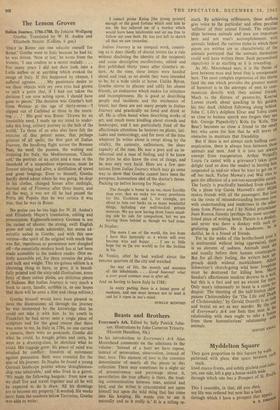Beasts and Brothers
Everyman's Ark. Edited by Sally Patrick John- son. Illustrations by John Cameron Yrizarry. (Hamish Hamilton, 30s.)
IN his introduction to Everyman's Ark Alan Moorehead comments on the selections in the volume: 'Instead of a hunt we have repose, instead of persecution, observation, instead of fear, love. This element of love is the common denominator of nearly all the pieces in this collection. There may sometimes be a slight air of possessiveness and patronage about it, nevertheless the true affinity is there, the trust- ing communication between man, animal and bird, and the writer is concentrated not upon himself but upon the wild thing that has come into his keeping. He wants you to see it naturally and as it really is.' It is a telling re-
mark. By achieving selflessness, these authors give voice to the particular and often peculiar
`selfness' of their animal friends. The relation- ships between animals and men are important here and not man's accomplishments with animals. Indeed, the various styles in which these pieces are written are so characteristic of the animals portrayed that the 'animals themselves could well have written them. Such personalised objectivity is as startling as it is rewarding. As Mr. Moorehead says, it is the theme of love between man and beast that is omnipresent here. The most complex expression of this theme (and the one which provides the greatest source of humour) is in the attempts of men to com- municate directly with their animal friends. Much to the distress of passers-by, Konrad Lorenz crawls about quacking in his garden, his tiny duck children following along behind. John C. Lilly's dolphins Elvar and Tolva come so close to human speech one forgets they are fish. George Papashvily's Kola (in 'Kola, The Bear') becomes so close a friend to the small boy who cares for him that he will brave all obstacles to maintain that friendship.
But if there is not always such baffling corn- munication, there is always love between these animals and men. And it is love not alwaYs exempt from exasperation. Arthur Weigall's, Laura Ca camel with a grievance') takes greal delight (and so does the reader) in leaving hirri suspended in mid-air when he tries to get on or off her back. Farley Mowat's owl Wol tries to gain the affection of a not-too-susceptible curate. The family is practically banished from church.; On a plane trip Gavin Maxwell's otter IvIiibu makes friends with all the passengers. But Ove via the route of misunderstanding becomes love with understanding and tenderness in the selee- tions from Platero and I by Nobel prizewinner Juan Ramon Jimeniz (perhaps the most accon1P- fished piece of writing here). Platen) is a donkeY' and never was there a donkey with such in,; gratiating qualities. He is handsome, he dutiful, he is a friend of friends. Yet in the midst of this brotherhood (and it is sentimental without being oppressive), ther.e. is an element of sadness. Animals must and usually before their human counterparts' But for all their feeling, the writers here a?.: proach death without mawkishness. Alberie' Schweitzer's church-going wild boar Jose,P111,nie must be destroyed for killing hens. ma'll, Sandoz's affectionate muskrat drowns in a vvers, but this is a fact and not an excuse for nor Only man's inhumanity to beast is a cause despair. The shooting of the half-human clurn, panzee Cholmondeley (in The Life and DeaT of Cholmondeley,' by Gerald Durrell) is as rd and brutal an act as any murder. By the efi5 of Everyman's Ark one feels that man in relationship with men ought to take a less."rth
from humanitarians' relationshiP
a vvi vreoLl, STEVEN "—






























 Previous page
Previous page